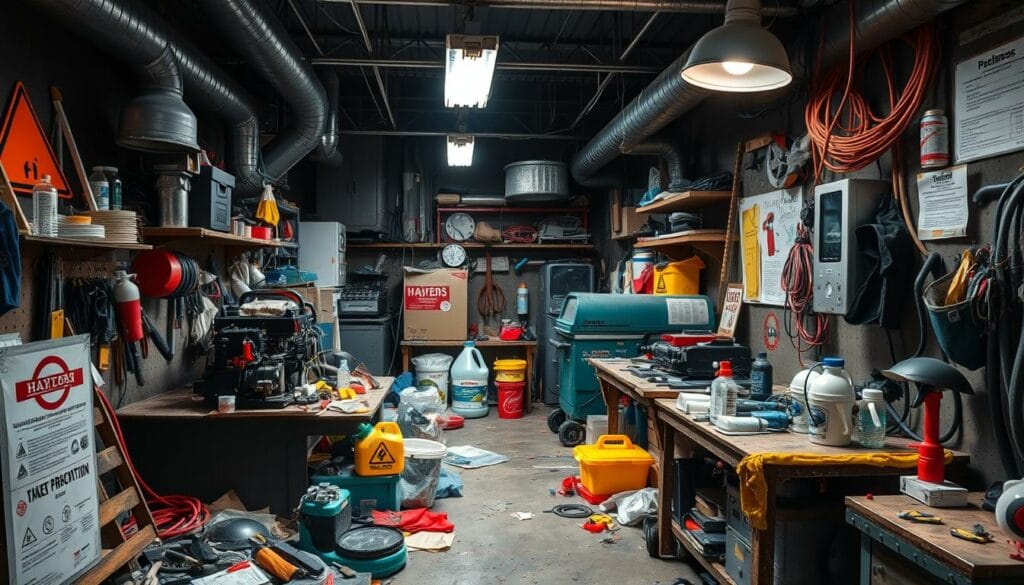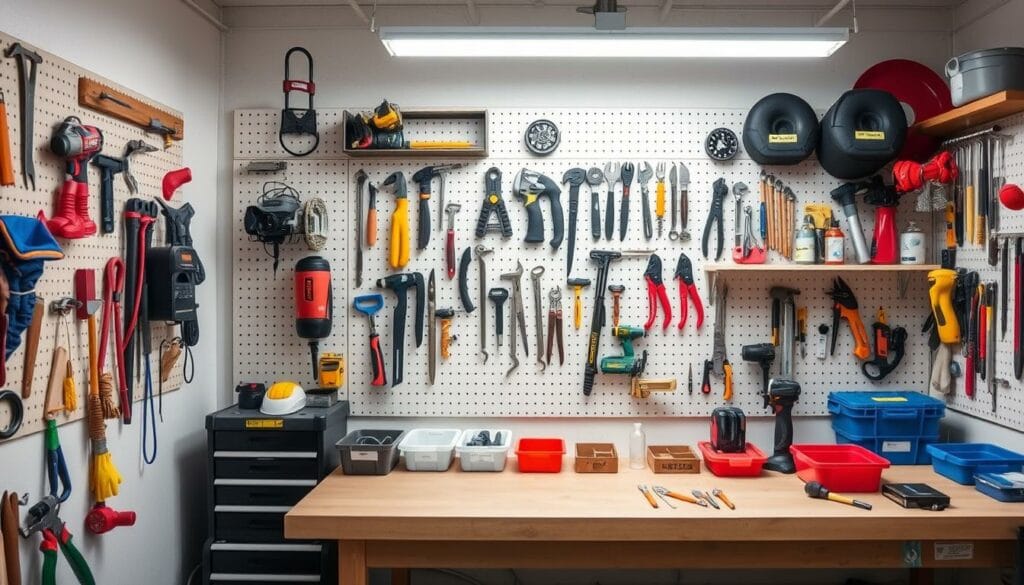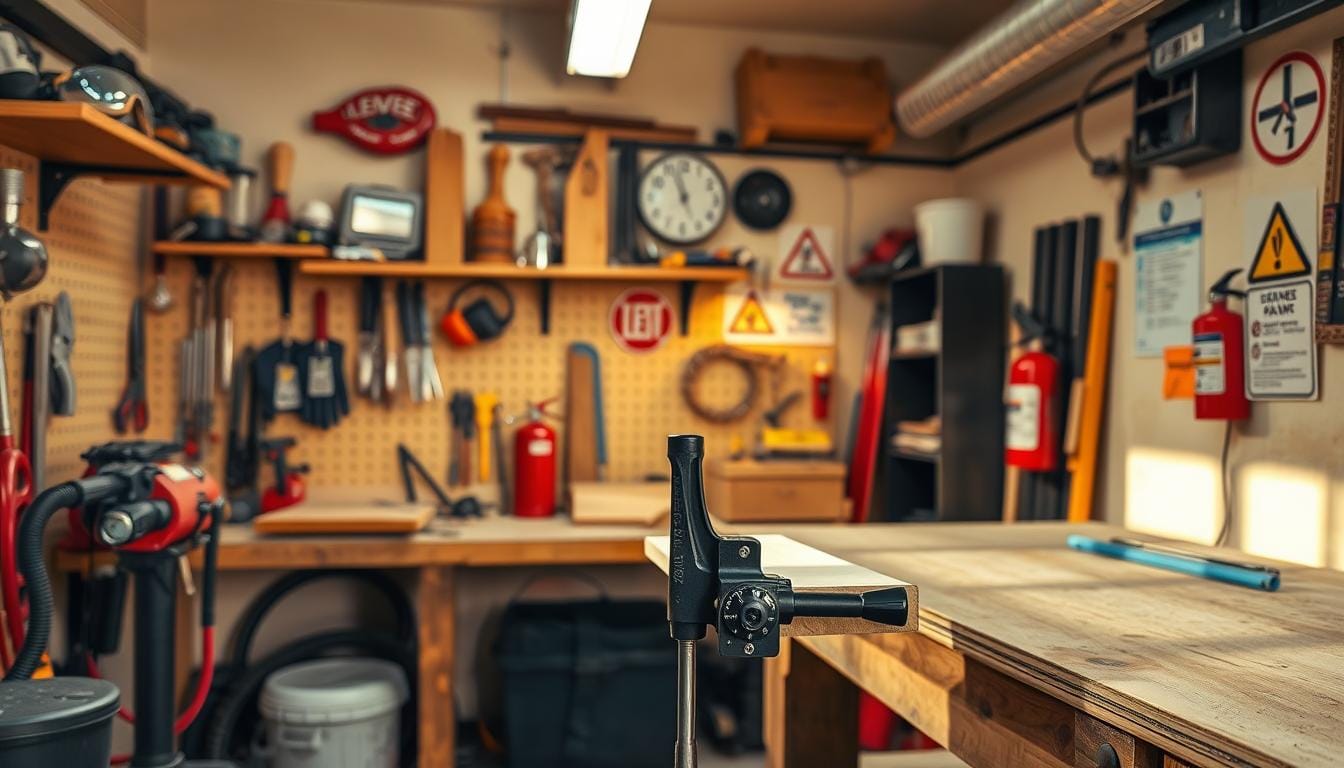Your workshop is where creativity comes alive. It’s where raw materials become extraordinary creations. But it’s also a place with potential hazards. Your safety must be a top priority in this creative space.
My first workshop experience taught me a valuable lesson. A tool slipped from my hand, nearly hitting my face. This close call made me realize safety isn’t optional. It inspired me to learn essential workshop safety tips.
Key Takeaways
- Identify common workshop hazards and risks to avoid accidents
- Invest in personal protective equipment (PPE) to safeguard against injuries
- Develop safe working habits to minimize the chances of mishaps
- Familiarize yourself with emergency procedures and first aid practices
- Prioritize a well-organized, clean, and well-lit workspace for optimal safety
Let’s explore essential safety measures for your workshop. These tips will help you work confidently and safely. They’ll create an environment where your creativity can flourish.
Ready to discover the secrets of a safe workshop experience? Let’s begin our safety journey together.
Understanding Workshop Hazards

Workshop safety is crucial. Potential hazards lurk around every corner. Being vigilant and understanding these risks is vital for a safe work environment.
Common tools and the workshop layout can pose dangers. Proper knowledge and caution are essential to prevent accidents.
Common Workshop Tools and Their Risks
Power saws and drills can cause serious injuries if misused. Deep cuts and crushed limbs are possible outcomes of improper handling.
Regular tool inspections are crucial. Following manufacturer guidelines helps reduce risks. Proper maintenance ensures safer equipment operation.
Identifying Potential Safety Hazards
- Inadequate lighting can create tripping and visibility hazards
- Cluttered workspaces increase the chances of slips, trips, and falls
- Faulty or outdated machinery may malfunction, putting users at risk
- Poorly maintained floors and surfaces can contribute to dangerous falls
Importance of Risk Assessment
Thorough risk assessments are key to workshop safety. They help identify hazards and implement control measures. This creates a safer work environment for everyone.
Regular assessments maintain vigilance. They ensure safety protocols remain effective over time. Keeping your team’s well-being a priority is crucial.
| Workshop Hazard | Potential Consequences | Recommended Safety Measures |
|---|---|---|
| Improper use of power tools | Lacerations, amputations, crushing injuries | Proper training, personal protective equipment (PPE), regular maintenance |
| Cluttered work areas | Trips, falls, struck-by incidents | Organized storage, clear walkways, good housekeeping |
| Inadequate machine guarding | Caught-in, caught-between injuries | Ensure proper machine guarding, follow manufacturer guidelines |
Understanding workshop hazards is crucial for safety. Take proactive steps to reduce risks. Create a safer, more productive work environment for everyone.
Essential Safety Gear for Workshop Use
Personal protective equipment (PPE) is vital for a safe workshop environment. The right safety gear shields you from potential hazards. It ensures your wellbeing during workshop activities.
Personal Protective Equipment (PPE) You Need
To safeguard yourself in the workshop, consider these essential PPE items:
- Safety glasses or goggles to protect your eyes from flying debris and particles
- Hearing protection, such as earplugs or earmuffs, to guard against noise-induced hearing loss
- Sturdy, steel-toed boots to prevent foot injuries from falling objects or sharp tools
- Gloves that offer protection against cuts, abrasions, and chemical exposure
- Respirators or dust masks to filter out harmful airborne particles and fumes
Choosing the Right Gear for Specific Tasks
The type of safety gear you need may vary depending on your tasks. Some jobs require additional protection like face shields or welding masks. Consider the potential hazards of each task when selecting safety equipment.
Maintenance of Safety Equipment
Proper maintenance ensures the effectiveness of your safety gear. Regularly inspect your PPE for signs of wear or damage. Replace items as needed to maintain protection.
Clean and store your equipment properly to extend its lifespan. Neglecting maintenance can compromise your protection and put you at risk.
“Safety is not just a slogan, it’s a way of life in the workshop. Investing in the right protective gear is the first step towards a secure and productive work environment.”
Prioritizing PPE use and maintenance enhances your safety in the workshop and workplace ergonomics. Your safety is paramount. Equip yourself with the necessary personal protective equipment for your workshop activities.
Best Practices for Safe Working Habits

A safe workshop is vital for your wellbeing and tool longevity. By adopting key practices, you can create a safer, more efficient workspace. These habits will help reduce accident risks and prevent damage.
Organizing Your Workspace for Safety
Create a well-organized, clutter-free work area. Arrange your Tool Maintenance supplies and equipment logically for easy access. Designate specific storage spaces for each item.
Keep walkways clear to avoid tripping hazards. Regularly clean and tidy your workshop to maintain Safety in the Workshop.
Safe Tool Handling Techniques
Proper tool handling is crucial for Safety in the Workshop. Use tools only for their intended purpose and never modify them. Unplug power tools when not in use.
Store tools safely when not needed. Inspect your tools regularly for wear or damage. Replace or repair them as needed for optimal Tool Maintenance.
Importance of Taking Breaks in the Workshop
Workshop work can be physically and mentally demanding. Take regular breaks to prevent fatigue and maintain focus. Set aside time for short breaks throughout the day.
Use break time to stretch, hydrate, and rest your mind. Staying refreshed and alert reduces accident risks and improves Safety in the Workshop.
| Workspace Organization Tips | Tool Handling Best Practices | Break Recommendations |
|---|---|---|
|
|
|
These best practices create a safer, more efficient workspace. They protect you and your valuable tools. A well-organized workshop is key for productive and Fire Prevention work.
Emergency Procedures and First Aid
Accidents happen. Be ready to respond quickly in your workshop. Stay calm and assess the situation. For chemical or electrical hazards, check this resource for safety guidelines.
What to Do in Case of an Accident
If someone gets hurt, give first aid right away. Call for medical help if needed. Keep a full first aid kit nearby.
Learn how to treat common workshop injuries. This includes cuts, burns, and eye irritations. Make sure your team knows these skills too.
Essential First Aid Supplies to Keep on Hand
Stock your kit with bandages, antiseptic, and medical tape. Add eye wash, burn gel, and CPR masks too. Put the kit where everyone can find it.
Check your supplies often. Replace any items that are used or expired. This keeps your first aid station ready for use.
Training and Preparedness for Emergencies
Train your team regularly on safety procedures. Learn how to use fire extinguishers and other safety gear. Practice these skills often.
Run emergency drills to keep everyone sharp. This helps everyone remember what to do when trouble strikes. Safety first in the workshop!
